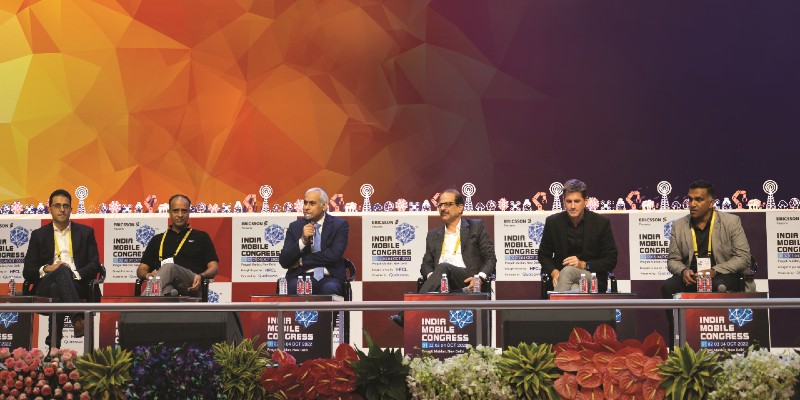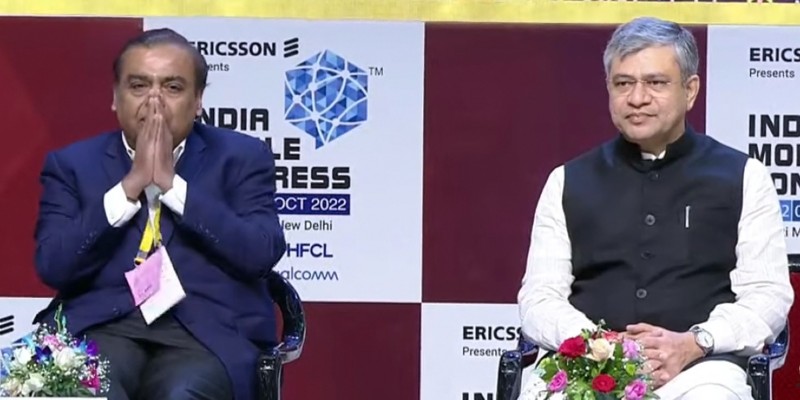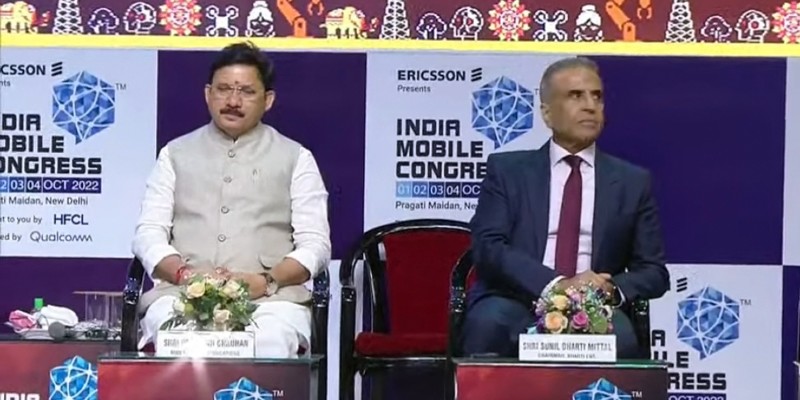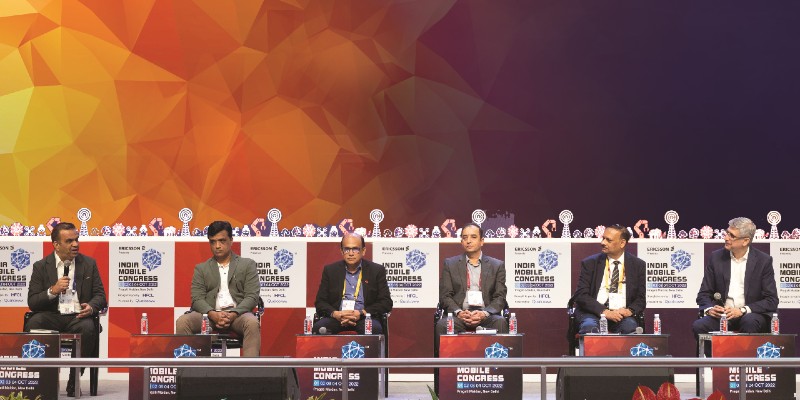CT Stories
Global CEO Conclave-Steering India to the new Digital Universe

Moderated by one of the industry captains, each of the three sessions invited guest speakers to share their views on a broad spectrum of issues.
In session 1, the panelists delved on a number of aspects including monetization, policy support and many others. The key takeaway was that once 5G innovation penetrates tier 2 and 3 cities, these markets will be a huge growth engine. And that is what 5G is poised to bring. Monetization no doubt is key and will remain a challenge for some time. Two years from now, the biggest use cases will be video surveillance, cloud gaming, and private 5G networks. However, time will tell which is the killer app!
 Akshaya Moondra
Akshaya Moondra
The Digital India vision was a big facilitating factor that kickstarted the activities in India, with the two key contributing factors being demonetization and Covid. Digital adoption accelerated, resulting in a GDP of USD 3.5 trillion. Going forward, on the use cases front, online gaming will in all probability lead the pack, followed by healthcare and driverless cars, although that will take time to evolve. In a shorter time period, with advent of Industry 4.0, 5G features will contribute to automated manufacturing, and IoT and industrial IoT will bring a lot of efficiency and productivity improvement, enabling India to leapfrog in this sector.
 Mysore Madhusudhan
Mysore Madhusudhan
While it is fantastic, that 5G and a huge number of use cases are expected to be delivered soon, there is a complete ecosystem of various players within the technology itself that deserves attention. While there are many technologies involved in this transformation, there are a few that are especially important to the industry including Artificial Intelligence, Big Data Analytics, Blockchain, Cloud and Edge Computing, Cybersecurity, Immersive Technology (such as Virtual Reality), Internet of Things (IoT), and Robotics. The integrated effect of the technologies, how it is consumed, the entire construct, the way the service is delivered and consumed by the end user will be the game changer. The conceptualization of utilizing 5G connectivity itself is coming into the fore. And the buyer has a very strategic role here. To drive digital growth, the complimentary role that each of the players identify and play is very critical. It cannot happen in a siloed, or individual’s approach. There needs to be a much more holistic ecosystem.
For more than 50 years AMD has driven innovation in high-performance computing, graphics, and visualization technologies. AMD employees are focused on building leadership high-performance and adaptive products that push the boundaries of what is possible. Billions of people, leading Fortune 500 businesses, and cutting-edge scientific research institutions around the world rely on AMD technology daily to improve how they live, work, and play.
 Salil Raje
Salil Raje
As a company that offers high-performance and adaptive processor technologies, combining CPUs, GPUs, FPGAs, Adaptive SoCs and deep software expertise while adding value on our platform, there are many areas we collaborate with our customers, the operators, OEMs, silicon vendor solution vendors, including some of the 200-odd startups. An important area in terms of collaboration is pooling in more talent and finally providing 5G technology and exporting it to the rest of the world.
 Narendra Narayana
Narendra Narayana
Now that the ecosystem is in place, and there are enough customers, it is time for us to power our own operators and help launch 5G services and invest in the latest technologies, be they, Open RAN, cloud-native automation or edge cloud. Manufacturing of hardware is equally important. And so is democratizing innovation, so that it comes from the villages and small towns of India. If with this approach, we connect a billion people in India, we could very well connect another three billion people, who do not have connectivity in the world.
 Puneet Sethi
Puneet Sethi
Digital adoption by India’s businesses has so far been uneven, but now digital business models fullfilled by the mobile sector are proliferating across most sectors. Entertainment, payments, banking, earlier done on computers are all done on the mobile phones. And this depends on three pillars–devices, apps, applications; infrastructure; and connectivity. While the Indian ecosystem is very vibrant on apps with so many startups being set up, and a lot of innovation is being done on devices, including keeping them affordable, it is infrastructure and connectivity that need attention.
The recent 5G launch by the PM was fascinating, with telcos working backwards from how the use cases are delivered, and then figuring out how to deliver that kind of experience. It would accelerate the process and help design the ecosystem, particularly if it is on open and collaborative interfaces and partnerships.
At Mavneir too, the emphasis is on open interfaces. The end-to-end portfolio of products, from IMS to packet core to RAN, are all based on open interfaces, and on our work with more partners than anywhere, including infrastructure OEMs, thus bringing in vendor diversity and better pricing for the telcos.
AREAS OF CONCERN
 Akshaya Moondra
Akshaya Moondra
In a country where tariffs are the lowest, India’s telecom industry has the highest levies anywhere in the world. An 18 percent GST, 12 percent license fee and spectrum usage charges, amounting to 30 percent, plus 28 percent as the cost of spectrum, make it 58 percent of the revenue, reflected as government levies. It is important that the government reduces the burden on the industry, so that operational cash can be released for investments and for migration of technology, in the capital-intensive industry that this is. Right of way continues to be a major issue.
 Narendra Narayana
Narendra Narayana
Now that the ecosystem is in place, and there are enough customers, it is time for us to power our own operators and help launch 5G services and invest in the latest technologies, be they, Open RAN, cloud-native automation or edge cloud. Manufacturing of hardware is equally important. And so is democratizing innovation, so that it comes from the villages and small towns of India. If with this approach, we connect a billion people in India, we could very well connect another three billion people, who do not have connectivity in the world.
 Puneet Sethi
Puneet Sethi
5G represents a big investment. And while ARPUs are south bound, the requisite CapEx and OpEx are north bound. And the use cases, as healthcare, require a network that is so programmable, so automatable, that it can serve hundreds of private network customers, each of them not so big, in geographically different locations, with different needs. The provider needs to be able to configure slices, deliver what is needed and monetize 5G investments. The capability to automate and innovate comes with the whole framework of open virtualized RAN. Similarly, on the platform side, in the IoT space, the automation on public and private cloud can be leveraged as it is on the cloud-native application. That is how we get innovation. Speed and velocity are then easy. A policy to incentivize open solutions, made-in-India solutions would go a long way.

The esteemed panelists were Sanjay Kaul, President, Service Provider Business, Asia Pacific & Japan, Cisco; Ajay Chitkara, CEO-Airtel Business, Bharti Airtel; Sanjay Malik, SVP and Head of Market, India Region, Nokia; Ludvig Landgren, Vice President Digital Services & Managed Services IT, South-East Asia, India and Oceania, Ericsson; and C B Velayuthan, Global Managing Director, Equinix. The session was moderated by Akhilesh Tuteja, Global Head – Cyber Security Consulting and India Head – Digital Consulting, KPMG India.
In session 2, the panelists unanimously agreed that entertainment, followed by healthcare are the two use cases that will drive maximum 5G revenue. They were worried for agriculture that constitutes 23 percent of India’s GDP and 60 percent of employment. And it may take years to find a model that works, and this cannot be acceptable. Yet, agriculture is the backbone of the country, and if productivity is increased even by 10 percent, half the costs can be recovered.
5G can only reach the masses once it is an affordable service. For that, costs will have to be lowered, and all the stakeholders will need to pitch in, be it equipment makers, telcos, or others. Building the ecosystem is super important because the benefits are far greater than the complexity that is being created with 5G. And the industry will have to take the responsibility to create the use cases and enable India to see through the vibrant opportunity that 5G offers.
 Ajay Chitkara
Ajay Chitkara
“Airtel’s strategy for 5G is focused on three key pillars. Continued investment on digital infrastructure, continued focus on building the IoT platform including NB-IoT, and building data centres not only in the top 10 cities but also in 120 edge locations, as for 5G to operate, data will be working on the edge sites. And once, these platforms are ready, it is imperative our alliances are in place. The ecosystem is extremely important, be it of system integrators, OEMs, cloud providers, or more importantly, innovations with startups.
 Sanjay Malik
Sanjay Malik
India is not late in launching 5G services, as commented by many, although we do lag slightly on technology. In fact, India has the advantage that the technology is proven, some use cases developed, and will not face any teething problems. And going by past experience, UPI payments being a case in point, I expect, within three years, 5G services to be available all over the country, and with larger numbers, perhaps more than anywhere else on the globe.
While I see monetization from use cases in healthcare, manufacturing, and above all entertainment sectors, impact on agriculture will take at least four to five years.
 Ludvig Landgren
Ludvig Landgren
The inaugural session of IMC 2022 portrayed a beautiful India, where the government, the industry, and the entire ecosystem are working together toward a common goal. And the operator landscape is no different from any developed country in the world. According to the Ericsson Mobility report, by 2027, India is expected to have 500 million 5G subscribers, out of a total 4.4 billion worldwide. That is absolutely commendable.
 Sanjay Kaul
Sanjay Kaul
5G gives us an excuse to transform the network, lower the cost per byte, and give digital power en masse. Apart from extensive fiberization, India needs robust transport networks, for that will be the showstopper. It is the transport infrastructure that will overlay a wide range of service technologies, with associated IP-based service-level agreements (SLAs), including BGP-based VPN technologies, such as EVPNs and VPNv4/v6s, and emerging SD-WAN VPN technologies.
 CB Velayuthan
CB Velayuthan
With 5G, India gets the opportunity to connect globally and leverage the entire ecosystem that is available and get the benefit of that.
Glimpses – Inaugural Session






The esteemed panelists were Rakesh Vij, CEO, Truminds; Tushar Agnihotri, CEO – India, Route Mobile Ltd., Marshal Correia, Vice President and General Manager, India, South Asia, Red Hat; Sanjay Nayak, CEO & Managing Director, Tejas Networks; and PK Purwar, BSNL, CMD. The session was moderated by Harsha Razdan, Co-Head for Clients & Markets, KPMG India.
In session 3, the panelists on this group were of the opinion that for the telecom sector, the sky is the limit, and the onus for 5G technology to succeed is on each of the stakeholders. They left the audience with the thought that digital world is here to stay and now needs to be embraced by all; founding pillars are laid and it is all about use cases; there is new energy of Atmanirbharta that offers an opportunity, which is unique to Indian manufacturers, and can be replicated around the world, so that India can contribute in multiple dimensions rather than just being a consumer of technology; and last but not the least – connectivity must be digitally inclusive to all sections of society and all geographies in the country.
 Harsha Razdan
Harsha Razdan
The very powerful technology available, whether from edge computing, cloud computing, or 5G has been changing lives. The CEOs, the seats of power who manage regulation and policy in the private sector and the public sector, need to collaborate and create the next wave of digital transformation for this country.
 PK Purwar
PK Purwar
India has made great progress in telecom services, and yet digital inclusion remains a distant dream for 400 million Indians, who continue to wait to be connected. The majority of applications today are directed toward solving the problem of the urban middle class. The entrepreneurs and start-ups that have sprung up in our country need to move beyond the urban middle class and see the huge opportunity from those still unconnected. Connectivity must be made digitally inclusive for all sections of society and all geographies in the country. And this connectivity must be robust. It should meet the needs of the people.
BSNL, being a government mandated provider, has taken the responsibility of connecting Indian citizens, living in far flung areas, and on islands and hilly terrains, where setting up networks is not financially viable. These include the seven Andaman and Nicobar Islands and 11 Lakshadweep islands. We are now connecting 30,000 villages where accessibility is a challenge. The scope of BharatNet has been extended up to all inhabited villages beyond GPs in the country.
 Sanjay Nayak
Sanjay Nayak
Covid seems to have accelerated Atmanirbharta, particularly for telecom equipment. The confidence and competence of the country in building R&D-driven telecom equipment seems to have dramatically increased. And, in line with our PM’s vision, India may soon find that it is not importing but exporting telecom equipment for 6G. Now that the ecosystem has been primed up with government policies, I’m extremely confident that in the next three to five years, India will become a global force, contributing to a much larger play in the digital universe as a contributor to technology products as well as standards.
There now seems to be a new energy in terms of Atmanirbharta, in terms of our own equipment, our own software, hardware, products, applications, apps, use cases, etc. The entire ecosystem’s approach, the industry’s and the government’s is that we are at a landmark stage, where we can now contribute in multiple dimensions rather than being a consumer of technology, buying from the rest of the world. It is a very exciting phase.
 Rakesh Vij
Rakesh Vij
While incentives are being given to hardware manufacturers, the government needs to look into supporting the software companies too, especially now as the telcos too are becoming more software-oriented, with intelligence being in the software. Now that the FinTech stack is well proven, we are working on building management solutions for multiple use cases.
We will see innovations reach the rural level, e.g., drones being used for pest control of the crop. The digital world is here to stay, and we all must adapt to it rather than run away from it.
 Marshal Correia
Marshal Correia
The founding pillars are laid, cloud infrastructure is in place, and the right architecture is adopted. The onus is now on bringing in use cases and new applications that work across the industry, and make a real difference, no matter which vertical it is. And this must be so at grassroots level, including for agriculture. Technology should be able to make the difference. That is the opportunity we are looking for.
 Tushar Agnihotri
Tushar Agnihotri
We are actively working on use cases. Enabling startups to reach their customers with a single API through their databases, and serving them in the way they want is one of them. Creating a mechanism that will ensure that consumers, especially illiterate people, are not swindled off their money when making online transfers is another. On a similar note, developing a multipurpose chat application through a master application, and being a key contributor to the growth of smart cities and IoT is also on the cards.
Intresting comments at another panel discussion at IMC 2022
 Nunzio Mirtillo
Nunzio Mirtillo
Head of Market Area SE Asia,
Oceania and India, Ericsson
“5G adoption in India will be faster than anywhere else in the world. Adoption of 4G indicated that the willingness of Indians to adopt new technology is second to none. And being competitive here means to be competitive in rest of the world. India for us is a very strategic market. We are invested here because of competence and demographic dividend.”
 Dr. Rajkumar Upadhyay
Dr. Rajkumar Upadhyay
Executive Director and Chairman,
C-DoT
“C-DoT’s 5G Core and radios are completely indigenously developed, and will be ready for commercial deployment in six months. The technology has been jointly developed by C-DoT, Jio’s Radisys India, VVDN Technologies and Wisig Networks. Our role is limited to technology development. We will sign a technology transfer agreement with vendors who will commercially deploy it.”













You must be logged in to post a comment Login